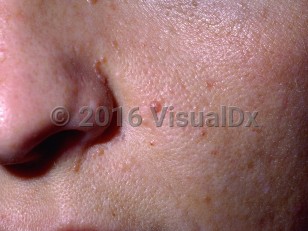Tuberous sclerosis in Adult
Alerts and Notices
Important News & Links
Synopsis

Tuberous sclerosis (TS), or tuberous sclerosis complex (TSC), also known as Bourneville disease, is an autosomal dominant, multisystem disorder caused by mutations in the genes for the proteins hamartin and tuberin (TSC1 and TSC2, respectively). It is characterized by tumor-like growths, or hamartomas, in almost every organ. The incidence of TSC is approximately 1 in 5000 to 10 000 live births. Two-thirds of infants with TSC are born to unaffected parents as a result of a sporadic mutation.
The phenotypic presentation of TSC is extremely variable with a range of clinical presentations, presenting over a range of ages and with a range of severity. The diagnosis is challenging due to the wide variation in severity and age-related penetrance of individual manifestations. In some cases, TSC is not diagnosed until adolescence or adulthood.
Clinical manifestations in childhood include the formation of various benign tumors involving the brain, skin, kidneys, heart, eyes, lung, and liver. TSC patients also have an increased risk of malignancy.
All patients will have at least one type of skin finding including hypomelanotic macules, adenoma sebaceum (facial angiofibromas), shagreen patches, and periungual fibromas.
A majority of TSC patients will have epilepsy, and more than half will have developmental delays collectively termed TSC-associated neuropsychiatric disorders (TAND). Brain lesions including glioneuronal hamartomas and periventricular giant cell astrocytomas are commonly identified in patients with TAND.
Kidney involvement is also very common. The prevalence of renal lesions increases with age and includes angiomyolipomas (the most common lesion isolated) as well as lymphangiomas, benign cysts, and renal cell carcinoma. Symptoms are often related to size, specifically with angiomyolipomas, which can cause pain, bleeding, and impaired renal function as they enlarge.
Cardiac involvement can occur but is not necessary in TSC. The most common lesion is a cardiac rhabdomyoma, and most children with rhabdomyomas have TSC.
Pulmonary involvement is also less common. It generally occurs in adults with TSC and is indistinguishable from lymphangioleiomyomatosis.
The phenotypic presentation of TSC is extremely variable with a range of clinical presentations, presenting over a range of ages and with a range of severity. The diagnosis is challenging due to the wide variation in severity and age-related penetrance of individual manifestations. In some cases, TSC is not diagnosed until adolescence or adulthood.
Clinical manifestations in childhood include the formation of various benign tumors involving the brain, skin, kidneys, heart, eyes, lung, and liver. TSC patients also have an increased risk of malignancy.
All patients will have at least one type of skin finding including hypomelanotic macules, adenoma sebaceum (facial angiofibromas), shagreen patches, and periungual fibromas.
A majority of TSC patients will have epilepsy, and more than half will have developmental delays collectively termed TSC-associated neuropsychiatric disorders (TAND). Brain lesions including glioneuronal hamartomas and periventricular giant cell astrocytomas are commonly identified in patients with TAND.
Kidney involvement is also very common. The prevalence of renal lesions increases with age and includes angiomyolipomas (the most common lesion isolated) as well as lymphangiomas, benign cysts, and renal cell carcinoma. Symptoms are often related to size, specifically with angiomyolipomas, which can cause pain, bleeding, and impaired renal function as they enlarge.
Cardiac involvement can occur but is not necessary in TSC. The most common lesion is a cardiac rhabdomyoma, and most children with rhabdomyomas have TSC.
Pulmonary involvement is also less common. It generally occurs in adults with TSC and is indistinguishable from lymphangioleiomyomatosis.
Codes
ICD10CM:
Q85.1 – Tuberous sclerosis
SNOMEDCT:
7199000 – Tuberous sclerosis
Q85.1 – Tuberous sclerosis
SNOMEDCT:
7199000 – Tuberous sclerosis
Look For
Subscription Required
Diagnostic Pearls
Subscription Required
Differential Diagnosis & Pitfalls

To perform a comparison, select diagnoses from the classic differential
Subscription Required
Best Tests
Subscription Required
Management Pearls
Subscription Required
Therapy
Subscription Required
References
Subscription Required
Last Reviewed:11/07/2018
Last Updated:01/25/2022
Last Updated:01/25/2022
Tuberous sclerosis in Adult

